Detailed Financial Analysis of JB Hi-Fi Limited: A Project Report
VerifiedAdded on 2020/05/04
|13
|3359
|104
Project
AI Summary
This project report offers a detailed financial analysis of JB Hi-Fi Limited, focusing on the company's performance from 2013 to 2017. The report begins with an introduction and company overview, highlighting JB Hi-Fi's history and market position. The core of the analysis involves a thorough examination of various financial ratios, categorized into profitability, liquidity, solvency, and market-based ratios. Profitability ratios, such as return on equity and earnings per share, are analyzed to assess the company's ability to generate profits. Liquidity ratios, including the current and quick ratios, evaluate JB Hi-Fi's ability to meet its short-term obligations. Solvency ratios, like debt-to-equity, assess the company's financial leverage and long-term stability. Market-based ratios, such as dividend yield, are also examined. The report provides a comparative analysis of the financial data, offering insights into the company's performance trends over the five-year period. The analysis concludes with an investment recommendation, suggesting that investing in the company would be favorable. The report references annual reports and financial data from various sources, and includes an appendix with the company's balance sheet. The study aims to provide a comprehensive understanding of JB Hi-Fi's financial health, stability, performance and profitability.
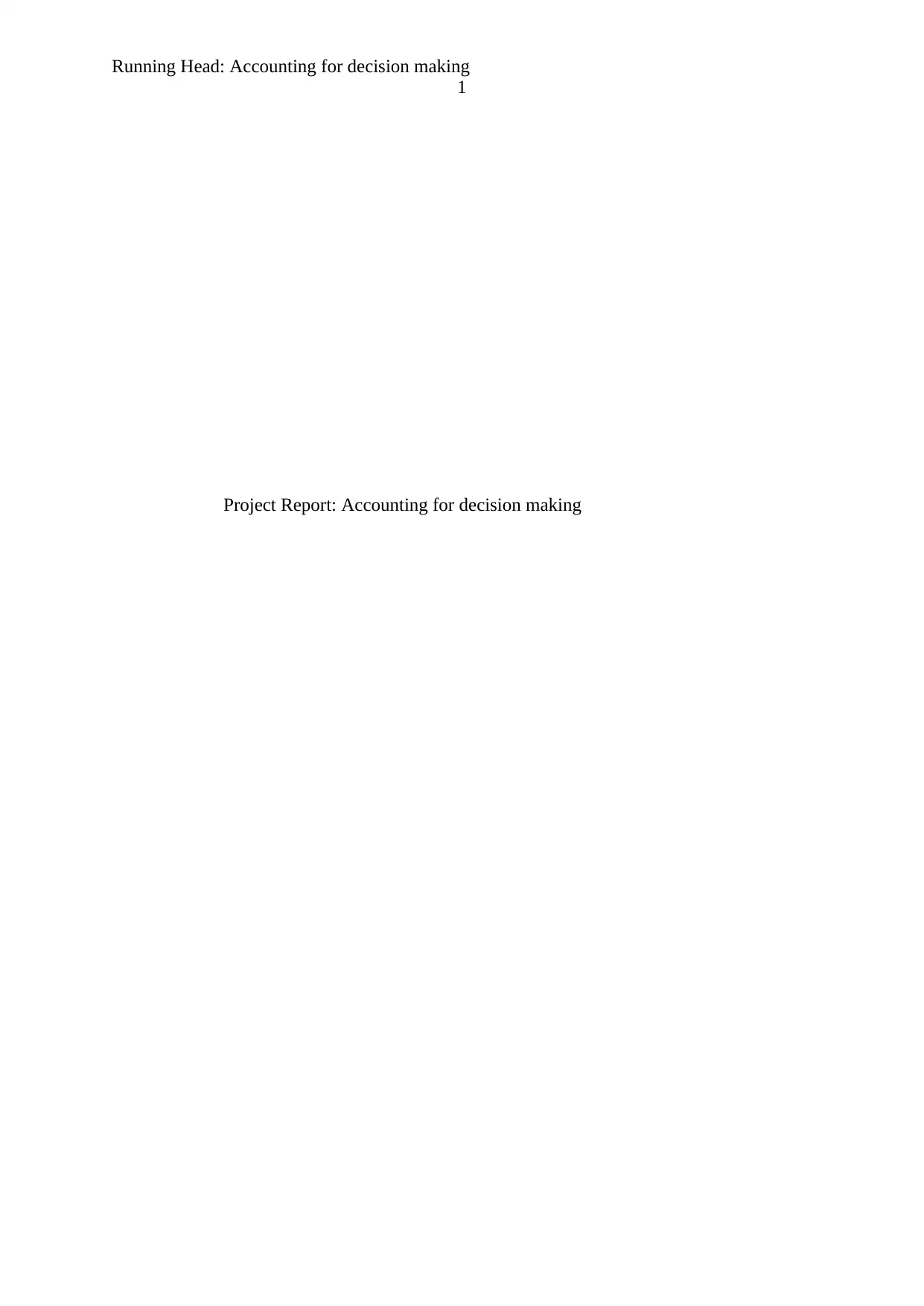
Running Head: Accounting for decision making
1
Project Report: Accounting for decision making
1
Project Report: Accounting for decision making
Paraphrase This Document
Need a fresh take? Get an instant paraphrase of this document with our AI Paraphraser

Accounting for decision making 2
Contents
Introduction.......................................................................................................................3
Company Overview..........................................................................................................3
Financial analysis of the company....................................................................................3
Ratio analysis................................................................................................................3
Analysis............................................................................................................................6
Conclusion........................................................................................................................7
References.........................................................................................................................8
Appendix...........................................................................................................................8
Contents
Introduction.......................................................................................................................3
Company Overview..........................................................................................................3
Financial analysis of the company....................................................................................3
Ratio analysis................................................................................................................3
Analysis............................................................................................................................6
Conclusion........................................................................................................................7
References.........................................................................................................................8
Appendix...........................................................................................................................8
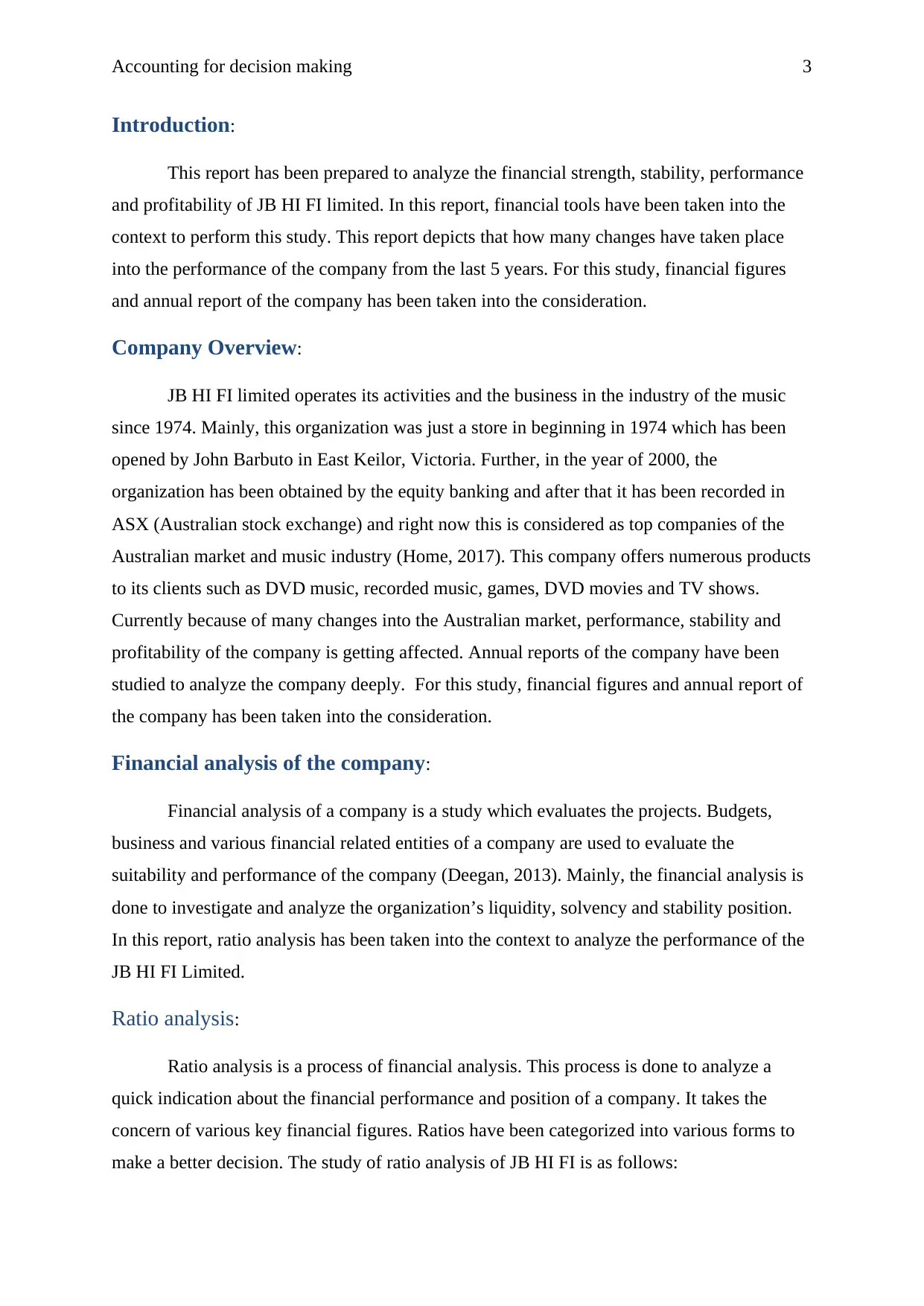
Accounting for decision making 3
Introduction:
This report has been prepared to analyze the financial strength, stability, performance
and profitability of JB HI FI limited. In this report, financial tools have been taken into the
context to perform this study. This report depicts that how many changes have taken place
into the performance of the company from the last 5 years. For this study, financial figures
and annual report of the company has been taken into the consideration.
Company Overview:
JB HI FI limited operates its activities and the business in the industry of the music
since 1974. Mainly, this organization was just a store in beginning in 1974 which has been
opened by John Barbuto in East Keilor, Victoria. Further, in the year of 2000, the
organization has been obtained by the equity banking and after that it has been recorded in
ASX (Australian stock exchange) and right now this is considered as top companies of the
Australian market and music industry (Home, 2017). This company offers numerous products
to its clients such as DVD music, recorded music, games, DVD movies and TV shows.
Currently because of many changes into the Australian market, performance, stability and
profitability of the company is getting affected. Annual reports of the company have been
studied to analyze the company deeply. For this study, financial figures and annual report of
the company has been taken into the consideration.
Financial analysis of the company:
Financial analysis of a company is a study which evaluates the projects. Budgets,
business and various financial related entities of a company are used to evaluate the
suitability and performance of the company (Deegan, 2013). Mainly, the financial analysis is
done to investigate and analyze the organization’s liquidity, solvency and stability position.
In this report, ratio analysis has been taken into the context to analyze the performance of the
JB HI FI Limited.
Ratio analysis:
Ratio analysis is a process of financial analysis. This process is done to analyze a
quick indication about the financial performance and position of a company. It takes the
concern of various key financial figures. Ratios have been categorized into various forms to
make a better decision. The study of ratio analysis of JB HI FI is as follows:
Introduction:
This report has been prepared to analyze the financial strength, stability, performance
and profitability of JB HI FI limited. In this report, financial tools have been taken into the
context to perform this study. This report depicts that how many changes have taken place
into the performance of the company from the last 5 years. For this study, financial figures
and annual report of the company has been taken into the consideration.
Company Overview:
JB HI FI limited operates its activities and the business in the industry of the music
since 1974. Mainly, this organization was just a store in beginning in 1974 which has been
opened by John Barbuto in East Keilor, Victoria. Further, in the year of 2000, the
organization has been obtained by the equity banking and after that it has been recorded in
ASX (Australian stock exchange) and right now this is considered as top companies of the
Australian market and music industry (Home, 2017). This company offers numerous products
to its clients such as DVD music, recorded music, games, DVD movies and TV shows.
Currently because of many changes into the Australian market, performance, stability and
profitability of the company is getting affected. Annual reports of the company have been
studied to analyze the company deeply. For this study, financial figures and annual report of
the company has been taken into the consideration.
Financial analysis of the company:
Financial analysis of a company is a study which evaluates the projects. Budgets,
business and various financial related entities of a company are used to evaluate the
suitability and performance of the company (Deegan, 2013). Mainly, the financial analysis is
done to investigate and analyze the organization’s liquidity, solvency and stability position.
In this report, ratio analysis has been taken into the context to analyze the performance of the
JB HI FI Limited.
Ratio analysis:
Ratio analysis is a process of financial analysis. This process is done to analyze a
quick indication about the financial performance and position of a company. It takes the
concern of various key financial figures. Ratios have been categorized into various forms to
make a better decision. The study of ratio analysis of JB HI FI is as follows:
⊘ This is a preview!⊘
Do you want full access?
Subscribe today to unlock all pages.

Trusted by 1+ million students worldwide
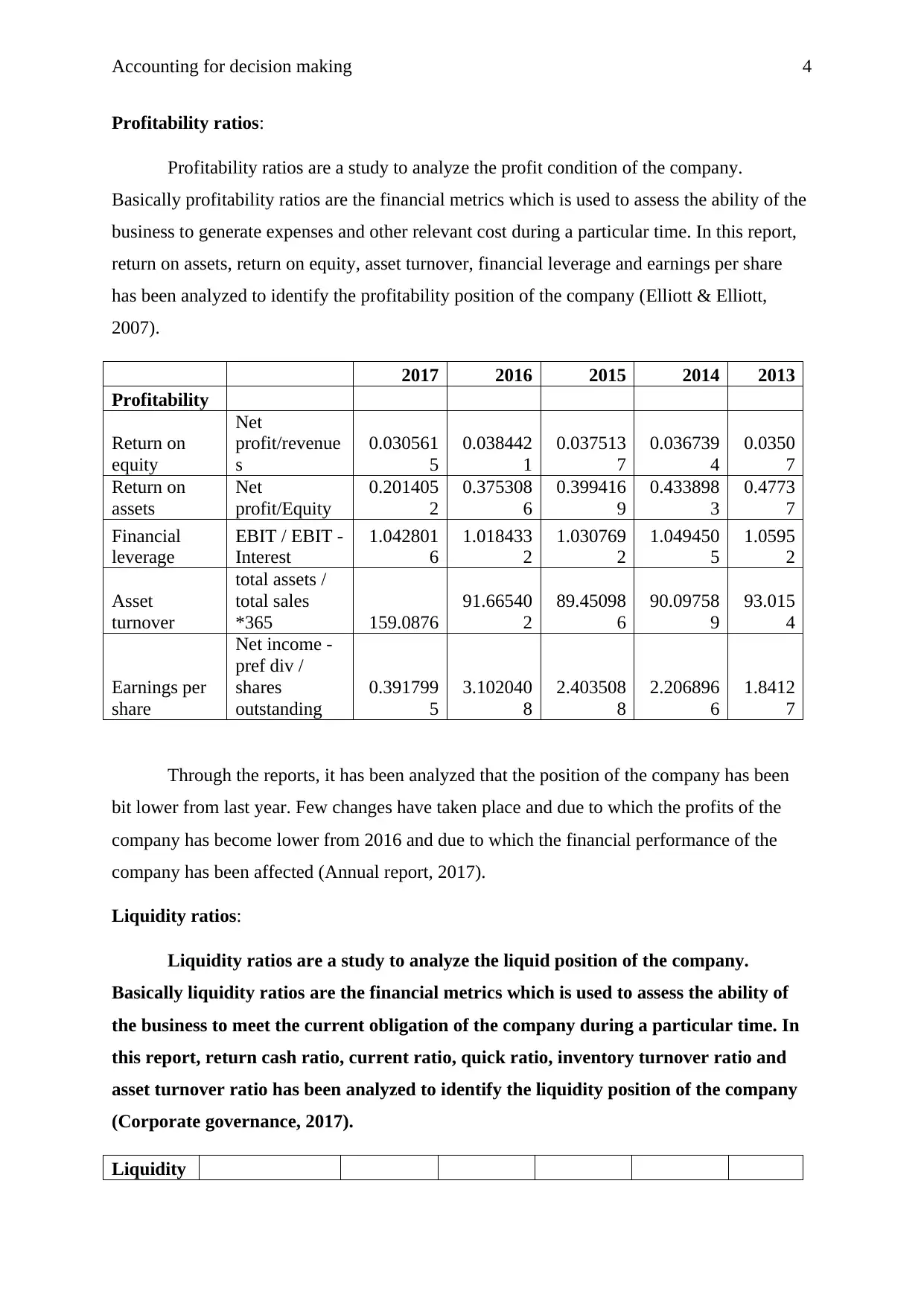
Accounting for decision making 4
Profitability ratios:
Profitability ratios are a study to analyze the profit condition of the company.
Basically profitability ratios are the financial metrics which is used to assess the ability of the
business to generate expenses and other relevant cost during a particular time. In this report,
return on assets, return on equity, asset turnover, financial leverage and earnings per share
has been analyzed to identify the profitability position of the company (Elliott & Elliott,
2007).
2017 2016 2015 2014 2013
Profitability
Return on
equity
Net
profit/revenue
s
0.030561
5
0.038442
1
0.037513
7
0.036739
4
0.0350
7
Return on
assets
Net
profit/Equity
0.201405
2
0.375308
6
0.399416
9
0.433898
3
0.4773
7
Financial
leverage
EBIT / EBIT -
Interest
1.042801
6
1.018433
2
1.030769
2
1.049450
5
1.0595
2
Asset
turnover
total assets /
total sales
*365 159.0876
91.66540
2
89.45098
6
90.09758
9
93.015
4
Earnings per
share
Net income -
pref div /
shares
outstanding
0.391799
5
3.102040
8
2.403508
8
2.206896
6
1.8412
7
Through the reports, it has been analyzed that the position of the company has been
bit lower from last year. Few changes have taken place and due to which the profits of the
company has become lower from 2016 and due to which the financial performance of the
company has been affected (Annual report, 2017).
Liquidity ratios:
Liquidity ratios are a study to analyze the liquid position of the company.
Basically liquidity ratios are the financial metrics which is used to assess the ability of
the business to meet the current obligation of the company during a particular time. In
this report, return cash ratio, current ratio, quick ratio, inventory turnover ratio and
asset turnover ratio has been analyzed to identify the liquidity position of the company
(Corporate governance, 2017).
Liquidity
Profitability ratios:
Profitability ratios are a study to analyze the profit condition of the company.
Basically profitability ratios are the financial metrics which is used to assess the ability of the
business to generate expenses and other relevant cost during a particular time. In this report,
return on assets, return on equity, asset turnover, financial leverage and earnings per share
has been analyzed to identify the profitability position of the company (Elliott & Elliott,
2007).
2017 2016 2015 2014 2013
Profitability
Return on
equity
Net
profit/revenue
s
0.030561
5
0.038442
1
0.037513
7
0.036739
4
0.0350
7
Return on
assets
Net
profit/Equity
0.201405
2
0.375308
6
0.399416
9
0.433898
3
0.4773
7
Financial
leverage
EBIT / EBIT -
Interest
1.042801
6
1.018433
2
1.030769
2
1.049450
5
1.0595
2
Asset
turnover
total assets /
total sales
*365 159.0876
91.66540
2
89.45098
6
90.09758
9
93.015
4
Earnings per
share
Net income -
pref div /
shares
outstanding
0.391799
5
3.102040
8
2.403508
8
2.206896
6
1.8412
7
Through the reports, it has been analyzed that the position of the company has been
bit lower from last year. Few changes have taken place and due to which the profits of the
company has become lower from 2016 and due to which the financial performance of the
company has been affected (Annual report, 2017).
Liquidity ratios:
Liquidity ratios are a study to analyze the liquid position of the company.
Basically liquidity ratios are the financial metrics which is used to assess the ability of
the business to meet the current obligation of the company during a particular time. In
this report, return cash ratio, current ratio, quick ratio, inventory turnover ratio and
asset turnover ratio has been analyzed to identify the liquidity position of the company
(Corporate governance, 2017).
Liquidity
Paraphrase This Document
Need a fresh take? Get an instant paraphrase of this document with our AI Paraphraser
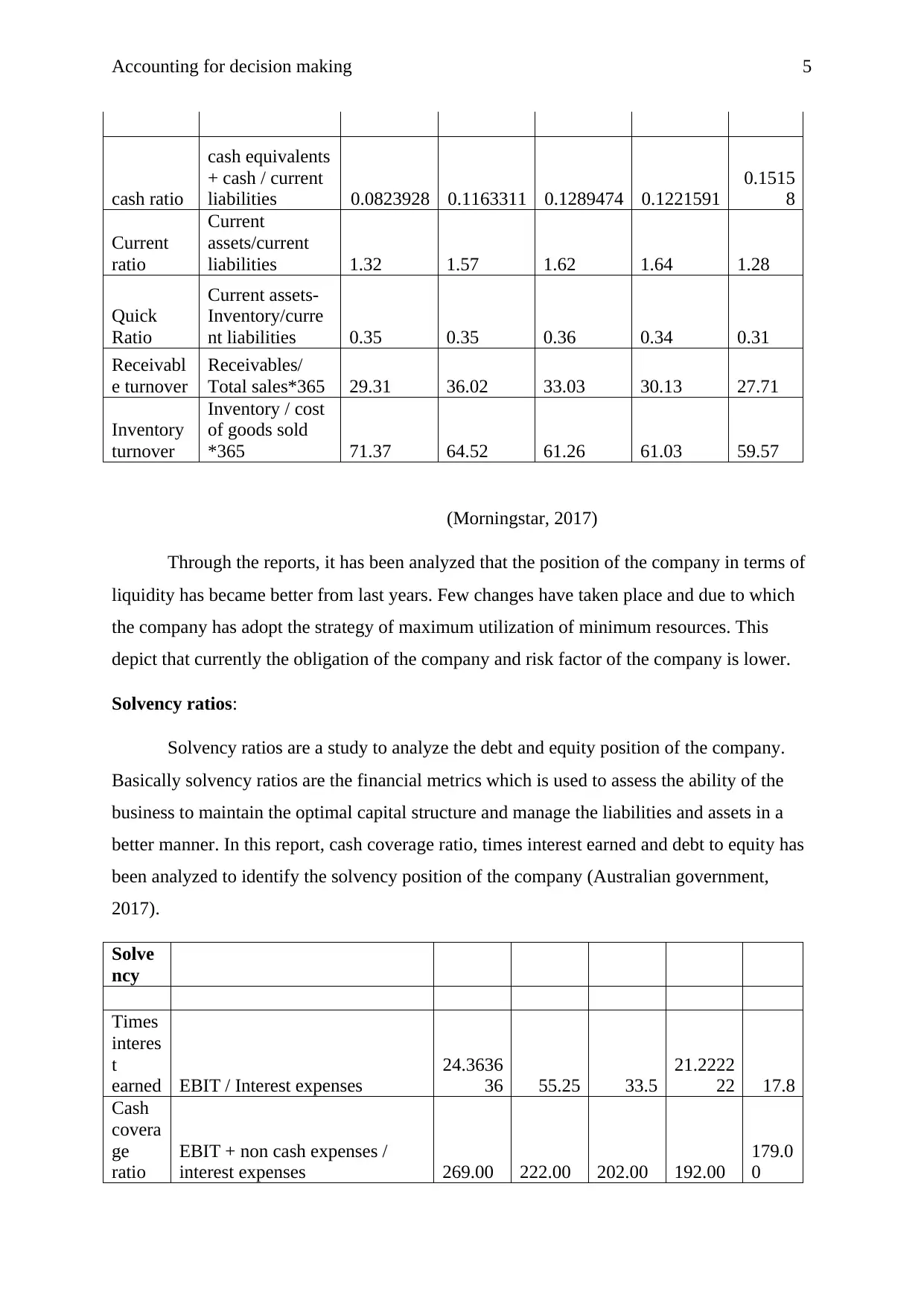
Accounting for decision making 5
cash ratio
cash equivalents
+ cash / current
liabilities 0.0823928 0.1163311 0.1289474 0.1221591
0.1515
8
Current
ratio
Current
assets/current
liabilities 1.32 1.57 1.62 1.64 1.28
Quick
Ratio
Current assets-
Inventory/curre
nt liabilities 0.35 0.35 0.36 0.34 0.31
Receivabl
e turnover
Receivables/
Total sales*365 29.31 36.02 33.03 30.13 27.71
Inventory
turnover
Inventory / cost
of goods sold
*365 71.37 64.52 61.26 61.03 59.57
(Morningstar, 2017)
Through the reports, it has been analyzed that the position of the company in terms of
liquidity has became better from last years. Few changes have taken place and due to which
the company has adopt the strategy of maximum utilization of minimum resources. This
depict that currently the obligation of the company and risk factor of the company is lower.
Solvency ratios:
Solvency ratios are a study to analyze the debt and equity position of the company.
Basically solvency ratios are the financial metrics which is used to assess the ability of the
business to maintain the optimal capital structure and manage the liabilities and assets in a
better manner. In this report, cash coverage ratio, times interest earned and debt to equity has
been analyzed to identify the solvency position of the company (Australian government,
2017).
Solve
ncy
Times
interes
t
earned EBIT / Interest expenses
24.3636
36 55.25 33.5
21.2222
22 17.8
Cash
covera
ge
ratio
EBIT + non cash expenses /
interest expenses 269.00 222.00 202.00 192.00
179.0
0
cash ratio
cash equivalents
+ cash / current
liabilities 0.0823928 0.1163311 0.1289474 0.1221591
0.1515
8
Current
ratio
Current
assets/current
liabilities 1.32 1.57 1.62 1.64 1.28
Quick
Ratio
Current assets-
Inventory/curre
nt liabilities 0.35 0.35 0.36 0.34 0.31
Receivabl
e turnover
Receivables/
Total sales*365 29.31 36.02 33.03 30.13 27.71
Inventory
turnover
Inventory / cost
of goods sold
*365 71.37 64.52 61.26 61.03 59.57
(Morningstar, 2017)
Through the reports, it has been analyzed that the position of the company in terms of
liquidity has became better from last years. Few changes have taken place and due to which
the company has adopt the strategy of maximum utilization of minimum resources. This
depict that currently the obligation of the company and risk factor of the company is lower.
Solvency ratios:
Solvency ratios are a study to analyze the debt and equity position of the company.
Basically solvency ratios are the financial metrics which is used to assess the ability of the
business to maintain the optimal capital structure and manage the liabilities and assets in a
better manner. In this report, cash coverage ratio, times interest earned and debt to equity has
been analyzed to identify the solvency position of the company (Australian government,
2017).
Solve
ncy
Times
interes
t
earned EBIT / Interest expenses
24.3636
36 55.25 33.5
21.2222
22 17.8
Cash
covera
ge
ratio
EBIT + non cash expenses /
interest expenses 269.00 222.00 202.00 192.00
179.0
0
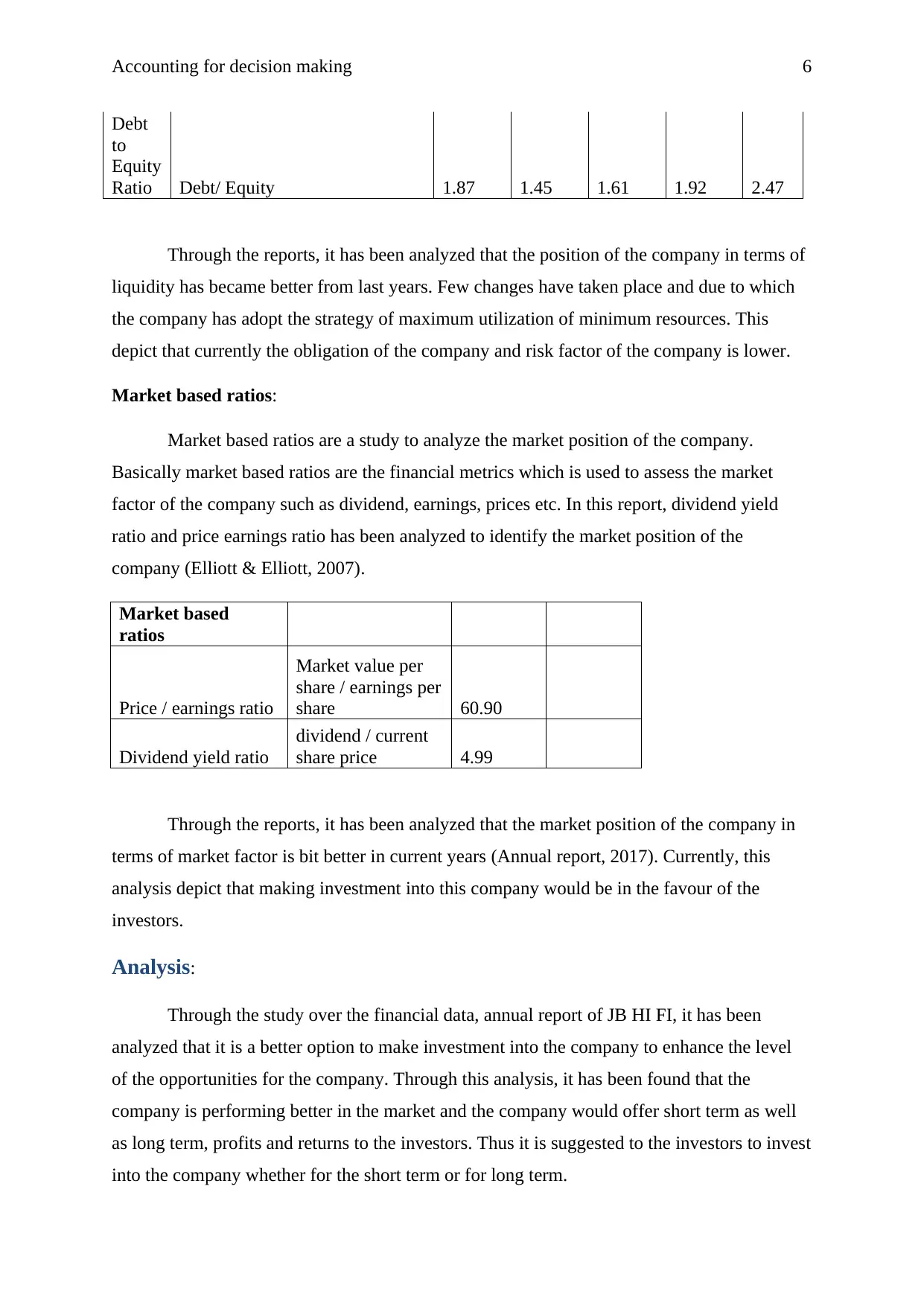
Accounting for decision making 6
Debt
to
Equity
Ratio Debt/ Equity 1.87 1.45 1.61 1.92 2.47
Through the reports, it has been analyzed that the position of the company in terms of
liquidity has became better from last years. Few changes have taken place and due to which
the company has adopt the strategy of maximum utilization of minimum resources. This
depict that currently the obligation of the company and risk factor of the company is lower.
Market based ratios:
Market based ratios are a study to analyze the market position of the company.
Basically market based ratios are the financial metrics which is used to assess the market
factor of the company such as dividend, earnings, prices etc. In this report, dividend yield
ratio and price earnings ratio has been analyzed to identify the market position of the
company (Elliott & Elliott, 2007).
Market based
ratios
Price / earnings ratio
Market value per
share / earnings per
share 60.90
Dividend yield ratio
dividend / current
share price 4.99
Through the reports, it has been analyzed that the market position of the company in
terms of market factor is bit better in current years (Annual report, 2017). Currently, this
analysis depict that making investment into this company would be in the favour of the
investors.
Analysis:
Through the study over the financial data, annual report of JB HI FI, it has been
analyzed that it is a better option to make investment into the company to enhance the level
of the opportunities for the company. Through this analysis, it has been found that the
company is performing better in the market and the company would offer short term as well
as long term, profits and returns to the investors. Thus it is suggested to the investors to invest
into the company whether for the short term or for long term.
Debt
to
Equity
Ratio Debt/ Equity 1.87 1.45 1.61 1.92 2.47
Through the reports, it has been analyzed that the position of the company in terms of
liquidity has became better from last years. Few changes have taken place and due to which
the company has adopt the strategy of maximum utilization of minimum resources. This
depict that currently the obligation of the company and risk factor of the company is lower.
Market based ratios:
Market based ratios are a study to analyze the market position of the company.
Basically market based ratios are the financial metrics which is used to assess the market
factor of the company such as dividend, earnings, prices etc. In this report, dividend yield
ratio and price earnings ratio has been analyzed to identify the market position of the
company (Elliott & Elliott, 2007).
Market based
ratios
Price / earnings ratio
Market value per
share / earnings per
share 60.90
Dividend yield ratio
dividend / current
share price 4.99
Through the reports, it has been analyzed that the market position of the company in
terms of market factor is bit better in current years (Annual report, 2017). Currently, this
analysis depict that making investment into this company would be in the favour of the
investors.
Analysis:
Through the study over the financial data, annual report of JB HI FI, it has been
analyzed that it is a better option to make investment into the company to enhance the level
of the opportunities for the company. Through this analysis, it has been found that the
company is performing better in the market and the company would offer short term as well
as long term, profits and returns to the investors. Thus it is suggested to the investors to invest
into the company whether for the short term or for long term.
⊘ This is a preview!⊘
Do you want full access?
Subscribe today to unlock all pages.

Trusted by 1+ million students worldwide
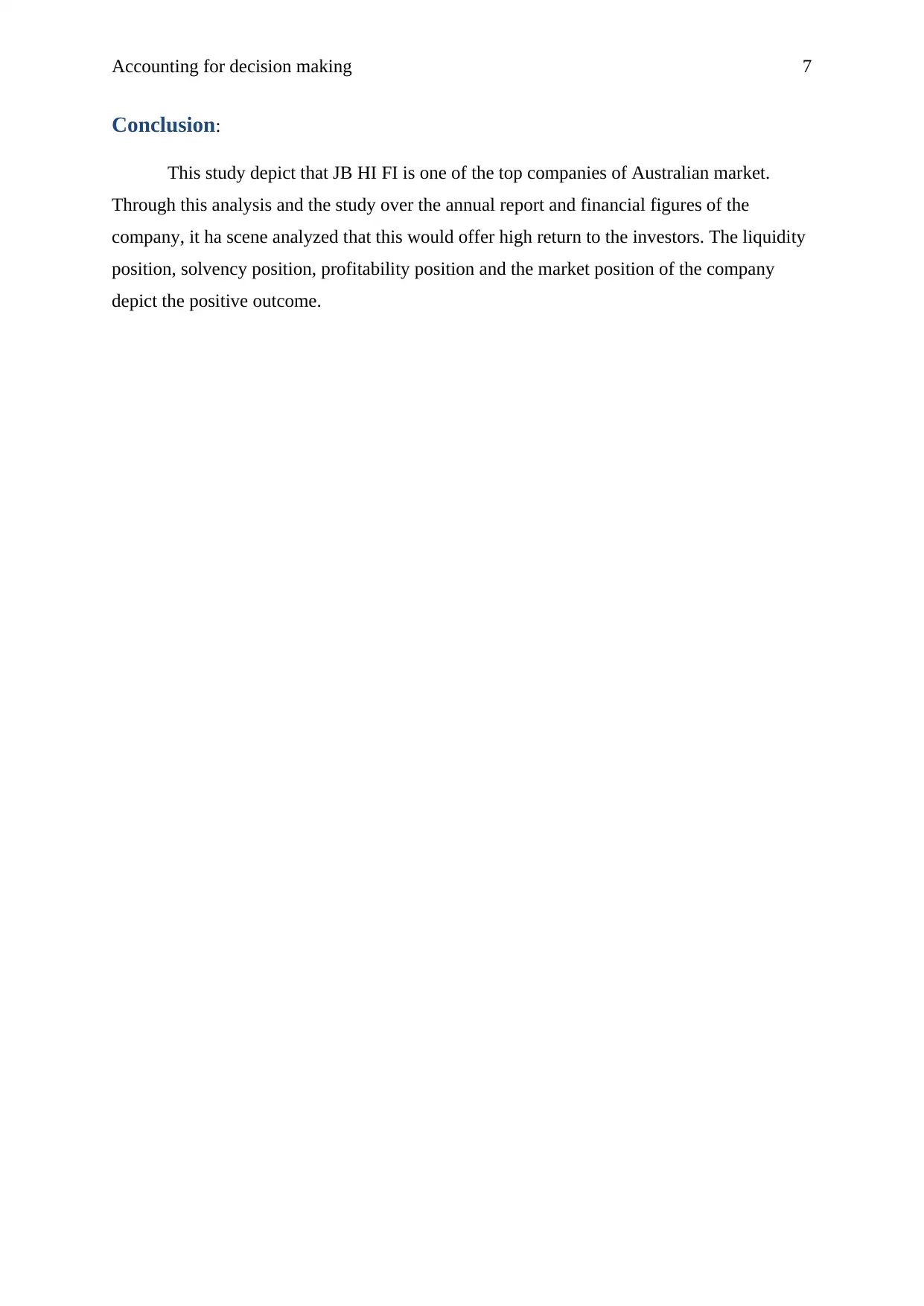
Accounting for decision making 7
Conclusion:
This study depict that JB HI FI is one of the top companies of Australian market.
Through this analysis and the study over the annual report and financial figures of the
company, it ha scene analyzed that this would offer high return to the investors. The liquidity
position, solvency position, profitability position and the market position of the company
depict the positive outcome.
Conclusion:
This study depict that JB HI FI is one of the top companies of Australian market.
Through this analysis and the study over the annual report and financial figures of the
company, it ha scene analyzed that this would offer high return to the investors. The liquidity
position, solvency position, profitability position and the market position of the company
depict the positive outcome.
Paraphrase This Document
Need a fresh take? Get an instant paraphrase of this document with our AI Paraphraser
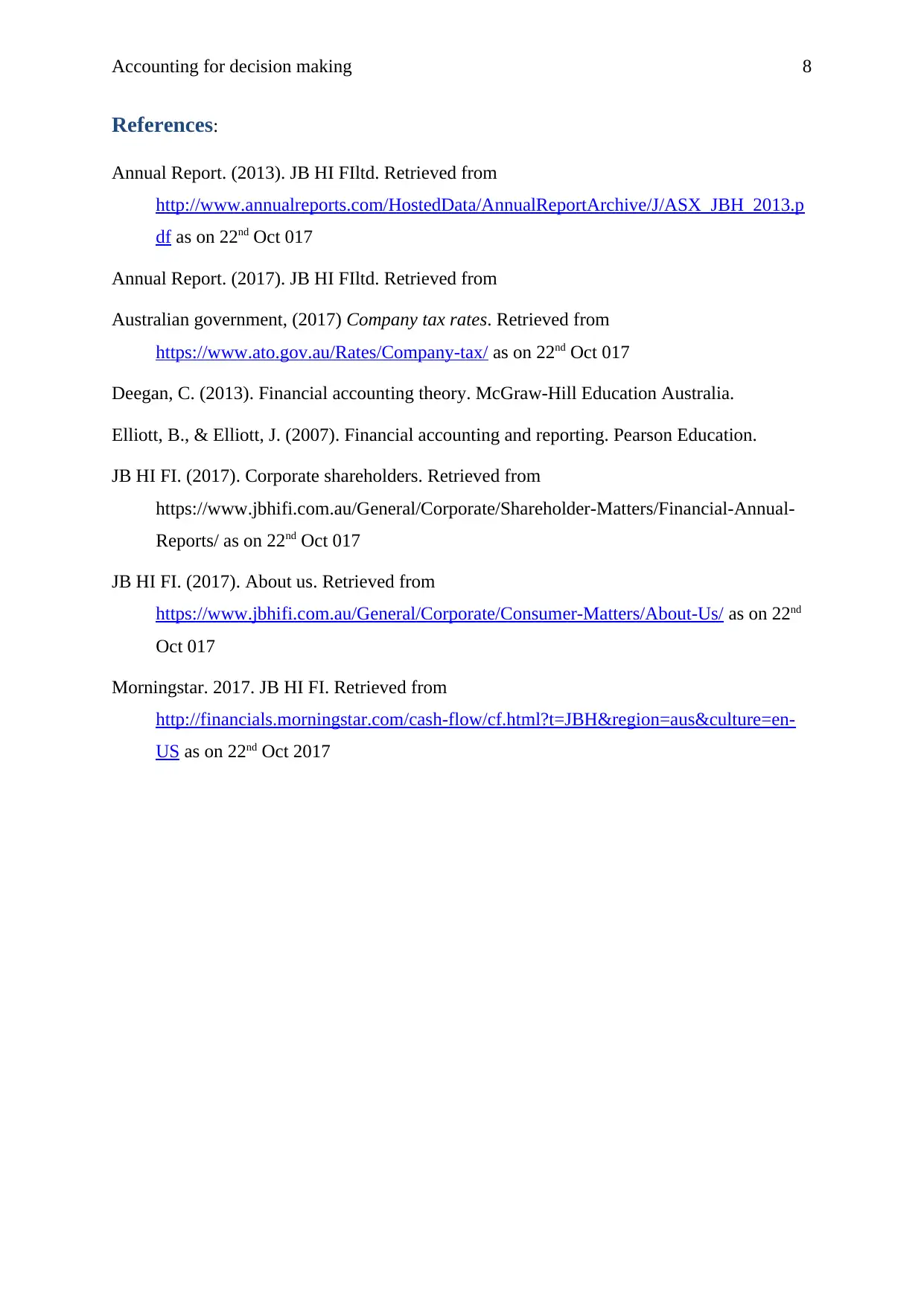
Accounting for decision making 8
References:
Annual Report. (2013). JB HI FIltd. Retrieved from
http://www.annualreports.com/HostedData/AnnualReportArchive/J/ASX_JBH_2013.p
df as on 22nd Oct 017
Annual Report. (2017). JB HI FIltd. Retrieved from
Australian government, (2017) Company tax rates. Retrieved from
https://www.ato.gov.au/Rates/Company-tax/ as on 22nd Oct 017
Deegan, C. (2013). Financial accounting theory. McGraw-Hill Education Australia.
Elliott, B., & Elliott, J. (2007). Financial accounting and reporting. Pearson Education.
JB HI FI. (2017). Corporate shareholders. Retrieved from
https://www.jbhifi.com.au/General/Corporate/Shareholder-Matters/Financial-Annual-
Reports/ as on 22nd Oct 017
JB HI FI. (2017). About us. Retrieved from
https://www.jbhifi.com.au/General/Corporate/Consumer-Matters/About-Us/ as on 22nd
Oct 017
Morningstar. 2017. JB HI FI. Retrieved from
http://financials.morningstar.com/cash-flow/cf.html?t=JBH®ion=aus&culture=en-
US as on 22nd Oct 2017
References:
Annual Report. (2013). JB HI FIltd. Retrieved from
http://www.annualreports.com/HostedData/AnnualReportArchive/J/ASX_JBH_2013.p
df as on 22nd Oct 017
Annual Report. (2017). JB HI FIltd. Retrieved from
Australian government, (2017) Company tax rates. Retrieved from
https://www.ato.gov.au/Rates/Company-tax/ as on 22nd Oct 017
Deegan, C. (2013). Financial accounting theory. McGraw-Hill Education Australia.
Elliott, B., & Elliott, J. (2007). Financial accounting and reporting. Pearson Education.
JB HI FI. (2017). Corporate shareholders. Retrieved from
https://www.jbhifi.com.au/General/Corporate/Shareholder-Matters/Financial-Annual-
Reports/ as on 22nd Oct 017
JB HI FI. (2017). About us. Retrieved from
https://www.jbhifi.com.au/General/Corporate/Consumer-Matters/About-Us/ as on 22nd
Oct 017
Morningstar. 2017. JB HI FI. Retrieved from
http://financials.morningstar.com/cash-flow/cf.html?t=JBH®ion=aus&culture=en-
US as on 22nd Oct 2017
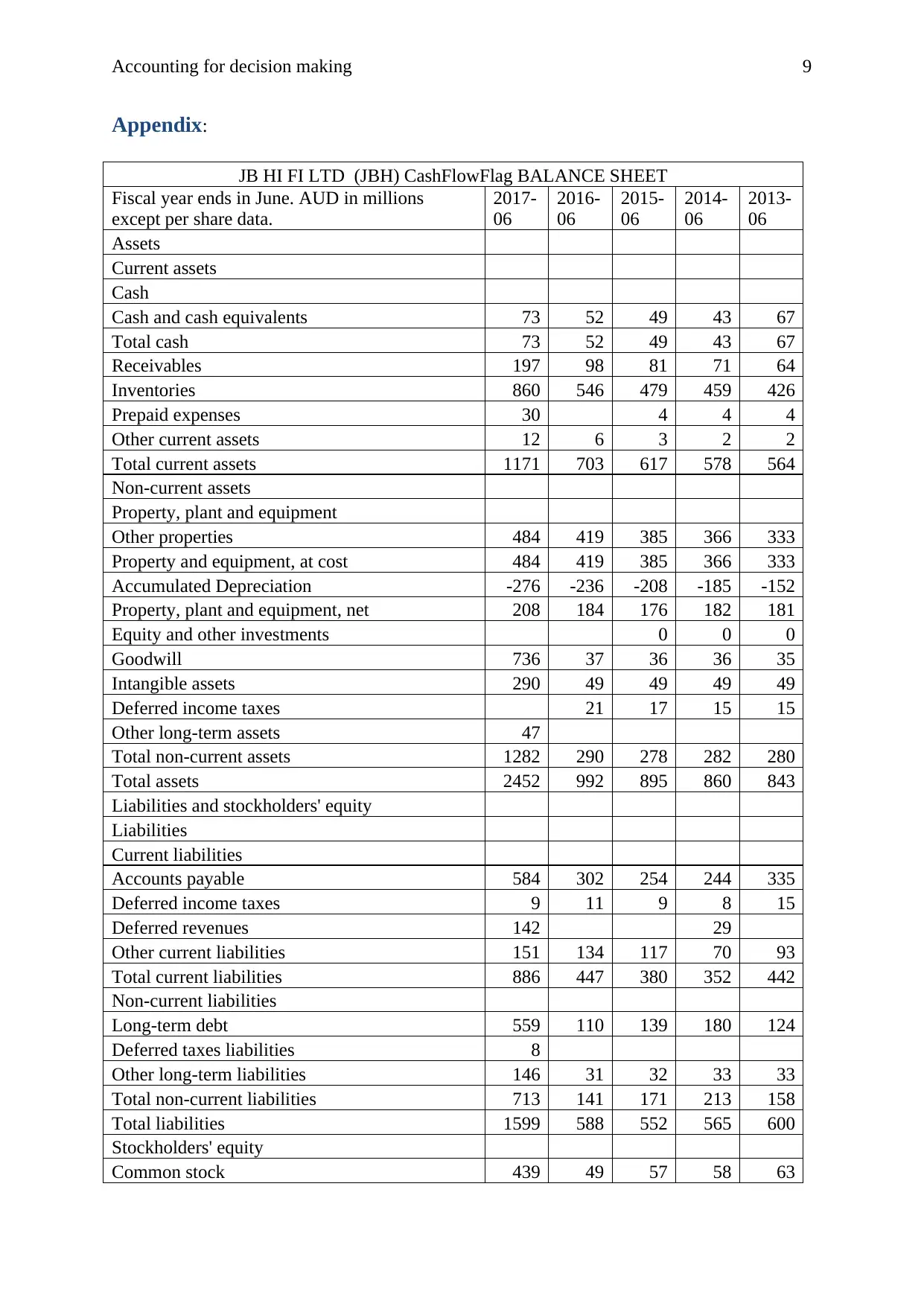
Accounting for decision making 9
Appendix:
JB HI FI LTD (JBH) CashFlowFlag BALANCE SHEET
Fiscal year ends in June. AUD in millions
except per share data.
2017-
06
2016-
06
2015-
06
2014-
06
2013-
06
Assets
Current assets
Cash
Cash and cash equivalents 73 52 49 43 67
Total cash 73 52 49 43 67
Receivables 197 98 81 71 64
Inventories 860 546 479 459 426
Prepaid expenses 30 4 4 4
Other current assets 12 6 3 2 2
Total current assets 1171 703 617 578 564
Non-current assets
Property, plant and equipment
Other properties 484 419 385 366 333
Property and equipment, at cost 484 419 385 366 333
Accumulated Depreciation -276 -236 -208 -185 -152
Property, plant and equipment, net 208 184 176 182 181
Equity and other investments 0 0 0
Goodwill 736 37 36 36 35
Intangible assets 290 49 49 49 49
Deferred income taxes 21 17 15 15
Other long-term assets 47
Total non-current assets 1282 290 278 282 280
Total assets 2452 992 895 860 843
Liabilities and stockholders' equity
Liabilities
Current liabilities
Accounts payable 584 302 254 244 335
Deferred income taxes 9 11 9 8 15
Deferred revenues 142 29
Other current liabilities 151 134 117 70 93
Total current liabilities 886 447 380 352 442
Non-current liabilities
Long-term debt 559 110 139 180 124
Deferred taxes liabilities 8
Other long-term liabilities 146 31 32 33 33
Total non-current liabilities 713 141 171 213 158
Total liabilities 1599 588 552 565 600
Stockholders' equity
Common stock 439 49 57 58 63
Appendix:
JB HI FI LTD (JBH) CashFlowFlag BALANCE SHEET
Fiscal year ends in June. AUD in millions
except per share data.
2017-
06
2016-
06
2015-
06
2014-
06
2013-
06
Assets
Current assets
Cash
Cash and cash equivalents 73 52 49 43 67
Total cash 73 52 49 43 67
Receivables 197 98 81 71 64
Inventories 860 546 479 459 426
Prepaid expenses 30 4 4 4
Other current assets 12 6 3 2 2
Total current assets 1171 703 617 578 564
Non-current assets
Property, plant and equipment
Other properties 484 419 385 366 333
Property and equipment, at cost 484 419 385 366 333
Accumulated Depreciation -276 -236 -208 -185 -152
Property, plant and equipment, net 208 184 176 182 181
Equity and other investments 0 0 0
Goodwill 736 37 36 36 35
Intangible assets 290 49 49 49 49
Deferred income taxes 21 17 15 15
Other long-term assets 47
Total non-current assets 1282 290 278 282 280
Total assets 2452 992 895 860 843
Liabilities and stockholders' equity
Liabilities
Current liabilities
Accounts payable 584 302 254 244 335
Deferred income taxes 9 11 9 8 15
Deferred revenues 142 29
Other current liabilities 151 134 117 70 93
Total current liabilities 886 447 380 352 442
Non-current liabilities
Long-term debt 559 110 139 180 124
Deferred taxes liabilities 8
Other long-term liabilities 146 31 32 33 33
Total non-current liabilities 713 141 171 213 158
Total liabilities 1599 588 552 565 600
Stockholders' equity
Common stock 439 49 57 58 63
⊘ This is a preview!⊘
Do you want full access?
Subscribe today to unlock all pages.

Trusted by 1+ million students worldwide
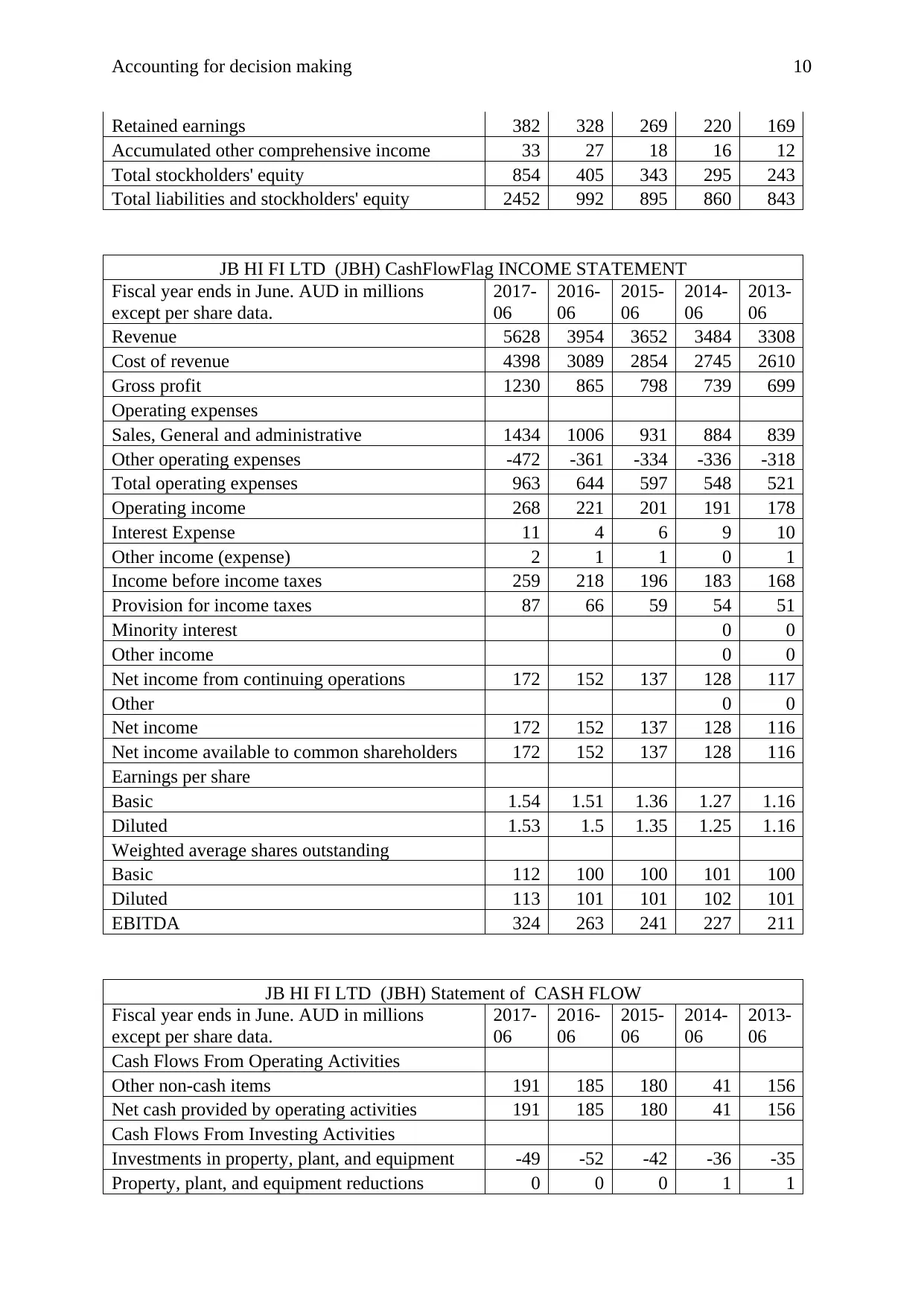
Accounting for decision making 10
Retained earnings 382 328 269 220 169
Accumulated other comprehensive income 33 27 18 16 12
Total stockholders' equity 854 405 343 295 243
Total liabilities and stockholders' equity 2452 992 895 860 843
JB HI FI LTD (JBH) CashFlowFlag INCOME STATEMENT
Fiscal year ends in June. AUD in millions
except per share data.
2017-
06
2016-
06
2015-
06
2014-
06
2013-
06
Revenue 5628 3954 3652 3484 3308
Cost of revenue 4398 3089 2854 2745 2610
Gross profit 1230 865 798 739 699
Operating expenses
Sales, General and administrative 1434 1006 931 884 839
Other operating expenses -472 -361 -334 -336 -318
Total operating expenses 963 644 597 548 521
Operating income 268 221 201 191 178
Interest Expense 11 4 6 9 10
Other income (expense) 2 1 1 0 1
Income before income taxes 259 218 196 183 168
Provision for income taxes 87 66 59 54 51
Minority interest 0 0
Other income 0 0
Net income from continuing operations 172 152 137 128 117
Other 0 0
Net income 172 152 137 128 116
Net income available to common shareholders 172 152 137 128 116
Earnings per share
Basic 1.54 1.51 1.36 1.27 1.16
Diluted 1.53 1.5 1.35 1.25 1.16
Weighted average shares outstanding
Basic 112 100 100 101 100
Diluted 113 101 101 102 101
EBITDA 324 263 241 227 211
JB HI FI LTD (JBH) Statement of CASH FLOW
Fiscal year ends in June. AUD in millions
except per share data.
2017-
06
2016-
06
2015-
06
2014-
06
2013-
06
Cash Flows From Operating Activities
Other non-cash items 191 185 180 41 156
Net cash provided by operating activities 191 185 180 41 156
Cash Flows From Investing Activities
Investments in property, plant, and equipment -49 -52 -42 -36 -35
Property, plant, and equipment reductions 0 0 0 1 1
Retained earnings 382 328 269 220 169
Accumulated other comprehensive income 33 27 18 16 12
Total stockholders' equity 854 405 343 295 243
Total liabilities and stockholders' equity 2452 992 895 860 843
JB HI FI LTD (JBH) CashFlowFlag INCOME STATEMENT
Fiscal year ends in June. AUD in millions
except per share data.
2017-
06
2016-
06
2015-
06
2014-
06
2013-
06
Revenue 5628 3954 3652 3484 3308
Cost of revenue 4398 3089 2854 2745 2610
Gross profit 1230 865 798 739 699
Operating expenses
Sales, General and administrative 1434 1006 931 884 839
Other operating expenses -472 -361 -334 -336 -318
Total operating expenses 963 644 597 548 521
Operating income 268 221 201 191 178
Interest Expense 11 4 6 9 10
Other income (expense) 2 1 1 0 1
Income before income taxes 259 218 196 183 168
Provision for income taxes 87 66 59 54 51
Minority interest 0 0
Other income 0 0
Net income from continuing operations 172 152 137 128 117
Other 0 0
Net income 172 152 137 128 116
Net income available to common shareholders 172 152 137 128 116
Earnings per share
Basic 1.54 1.51 1.36 1.27 1.16
Diluted 1.53 1.5 1.35 1.25 1.16
Weighted average shares outstanding
Basic 112 100 100 101 100
Diluted 113 101 101 102 101
EBITDA 324 263 241 227 211
JB HI FI LTD (JBH) Statement of CASH FLOW
Fiscal year ends in June. AUD in millions
except per share data.
2017-
06
2016-
06
2015-
06
2014-
06
2013-
06
Cash Flows From Operating Activities
Other non-cash items 191 185 180 41 156
Net cash provided by operating activities 191 185 180 41 156
Cash Flows From Investing Activities
Investments in property, plant, and equipment -49 -52 -42 -36 -35
Property, plant, and equipment reductions 0 0 0 1 1
Paraphrase This Document
Need a fresh take? Get an instant paraphrase of this document with our AI Paraphraser
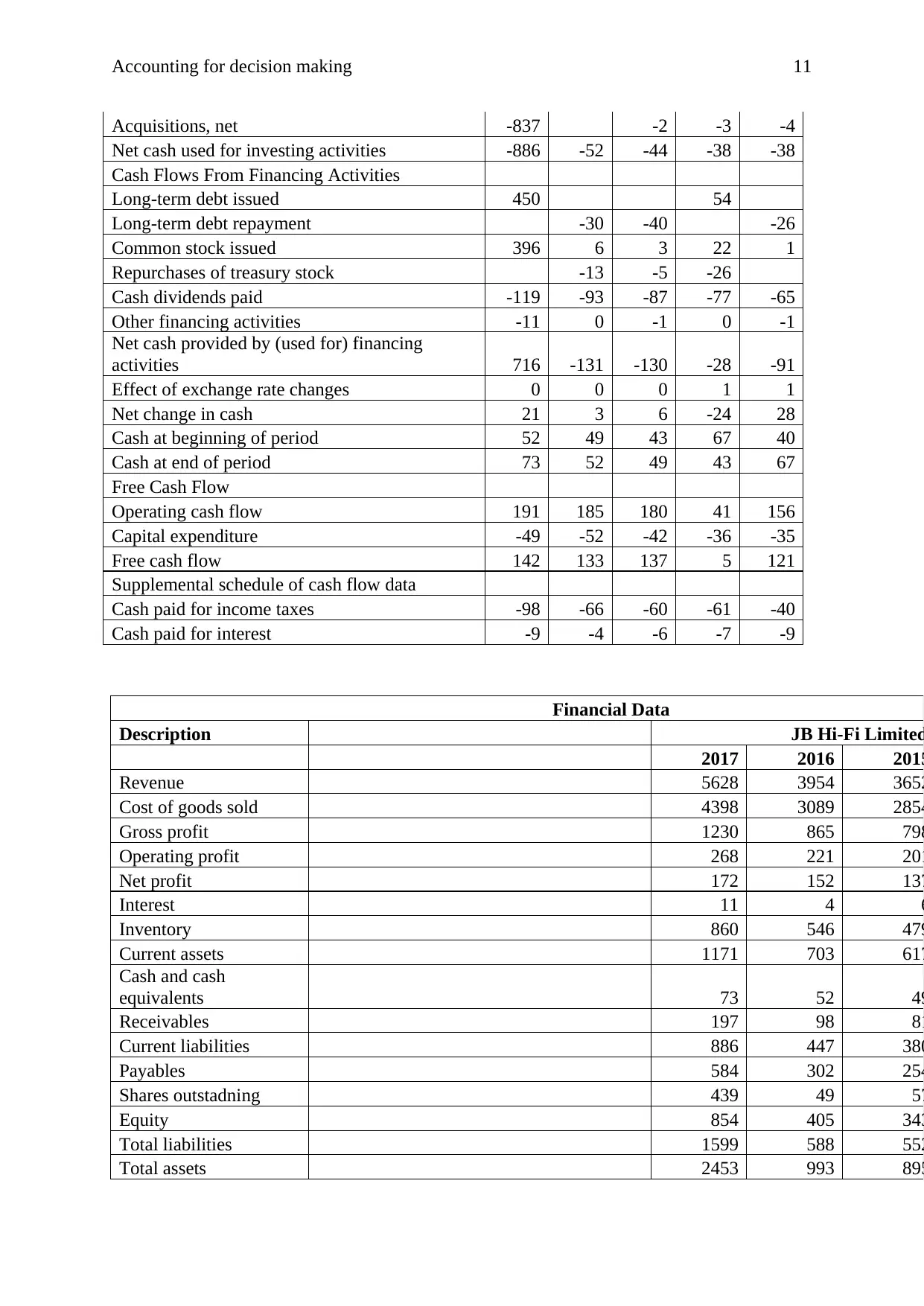
Accounting for decision making 11
Acquisitions, net -837 -2 -3 -4
Net cash used for investing activities -886 -52 -44 -38 -38
Cash Flows From Financing Activities
Long-term debt issued 450 54
Long-term debt repayment -30 -40 -26
Common stock issued 396 6 3 22 1
Repurchases of treasury stock -13 -5 -26
Cash dividends paid -119 -93 -87 -77 -65
Other financing activities -11 0 -1 0 -1
Net cash provided by (used for) financing
activities 716 -131 -130 -28 -91
Effect of exchange rate changes 0 0 0 1 1
Net change in cash 21 3 6 -24 28
Cash at beginning of period 52 49 43 67 40
Cash at end of period 73 52 49 43 67
Free Cash Flow
Operating cash flow 191 185 180 41 156
Capital expenditure -49 -52 -42 -36 -35
Free cash flow 142 133 137 5 121
Supplemental schedule of cash flow data
Cash paid for income taxes -98 -66 -60 -61 -40
Cash paid for interest -9 -4 -6 -7 -9
Financial Data
Description JB Hi-Fi Limited
2017 2016 2015
Revenue 5628 3954 3652
Cost of goods sold 4398 3089 2854
Gross profit 1230 865 798
Operating profit 268 221 201
Net profit 172 152 137
Interest 11 4 6
Inventory 860 546 479
Current assets 1171 703 617
Cash and cash
equivalents 73 52 49
Receivables 197 98 81
Current liabilities 886 447 380
Payables 584 302 254
Shares outstadning 439 49 57
Equity 854 405 343
Total liabilities 1599 588 552
Total assets 2453 993 895
Acquisitions, net -837 -2 -3 -4
Net cash used for investing activities -886 -52 -44 -38 -38
Cash Flows From Financing Activities
Long-term debt issued 450 54
Long-term debt repayment -30 -40 -26
Common stock issued 396 6 3 22 1
Repurchases of treasury stock -13 -5 -26
Cash dividends paid -119 -93 -87 -77 -65
Other financing activities -11 0 -1 0 -1
Net cash provided by (used for) financing
activities 716 -131 -130 -28 -91
Effect of exchange rate changes 0 0 0 1 1
Net change in cash 21 3 6 -24 28
Cash at beginning of period 52 49 43 67 40
Cash at end of period 73 52 49 43 67
Free Cash Flow
Operating cash flow 191 185 180 41 156
Capital expenditure -49 -52 -42 -36 -35
Free cash flow 142 133 137 5 121
Supplemental schedule of cash flow data
Cash paid for income taxes -98 -66 -60 -61 -40
Cash paid for interest -9 -4 -6 -7 -9
Financial Data
Description JB Hi-Fi Limited
2017 2016 2015
Revenue 5628 3954 3652
Cost of goods sold 4398 3089 2854
Gross profit 1230 865 798
Operating profit 268 221 201
Net profit 172 152 137
Interest 11 4 6
Inventory 860 546 479
Current assets 1171 703 617
Cash and cash
equivalents 73 52 49
Receivables 197 98 81
Current liabilities 886 447 380
Payables 584 302 254
Shares outstadning 439 49 57
Equity 854 405 343
Total liabilities 1599 588 552
Total assets 2453 993 895

Accounting for decision making 12
Market share price 23.86
Description Formula JB Hi-Fi Limited
2017 2016 2015
Profitability
Rqturn on equity Net profit/revenues 0.0305615 0.0384421 0.0375137
Return on assets Net profit/Equity 0.2014052 0.3753086 0.3994169
Financial leverage EBIT / EBIT - Interest 1.0428016 1.0184332 1.0307692
Asset turnover total assets / total sales *365 159.0876 91.665402 89.450986
Earkings per share Net income - pref div / shares outstanding 0.3917995 3.1020408 2.4035088
Liquidity
cash ratio cash equivalents + cash / current liabilities 0.0823928 0.1163311 0.1289474
Current ratio Current assets/current liabilities 1.32 1.57 1.62
Quick Ratio Current assets-Inventory/current liabilities 0.35 0.35 0.36
Receivable turnover Receivables/ Total sales*365 29.31 36.02 33.03
Inventory turnover Inventory / cost of goods sold *365 71.37 64.52 61.26
Market based ratios
Price / earings ratio Market value per share / earnings per share 60.90
Dividend yield ratio dividend / current share price 4.99
Solvency
Times inteest earned EBIT / Interest expenses 24.363636 55.25 33.5
Cash coverage ratio
EBIT + non cash expenses / interest
expenses 269.00 222.00 202.00
Debt to Equity Ratio Debt/ Equity
Market share price 23.86
Description Formula JB Hi-Fi Limited
2017 2016 2015
Profitability
Rqturn on equity Net profit/revenues 0.0305615 0.0384421 0.0375137
Return on assets Net profit/Equity 0.2014052 0.3753086 0.3994169
Financial leverage EBIT / EBIT - Interest 1.0428016 1.0184332 1.0307692
Asset turnover total assets / total sales *365 159.0876 91.665402 89.450986
Earkings per share Net income - pref div / shares outstanding 0.3917995 3.1020408 2.4035088
Liquidity
cash ratio cash equivalents + cash / current liabilities 0.0823928 0.1163311 0.1289474
Current ratio Current assets/current liabilities 1.32 1.57 1.62
Quick Ratio Current assets-Inventory/current liabilities 0.35 0.35 0.36
Receivable turnover Receivables/ Total sales*365 29.31 36.02 33.03
Inventory turnover Inventory / cost of goods sold *365 71.37 64.52 61.26
Market based ratios
Price / earings ratio Market value per share / earnings per share 60.90
Dividend yield ratio dividend / current share price 4.99
Solvency
Times inteest earned EBIT / Interest expenses 24.363636 55.25 33.5
Cash coverage ratio
EBIT + non cash expenses / interest
expenses 269.00 222.00 202.00
Debt to Equity Ratio Debt/ Equity
⊘ This is a preview!⊘
Do you want full access?
Subscribe today to unlock all pages.

Trusted by 1+ million students worldwide
1 out of 13
Related Documents
Your All-in-One AI-Powered Toolkit for Academic Success.
+13062052269
info@desklib.com
Available 24*7 on WhatsApp / Email
![[object Object]](/_next/static/media/star-bottom.7253800d.svg)
Unlock your academic potential
Copyright © 2020–2025 A2Z Services. All Rights Reserved. Developed and managed by ZUCOL.




